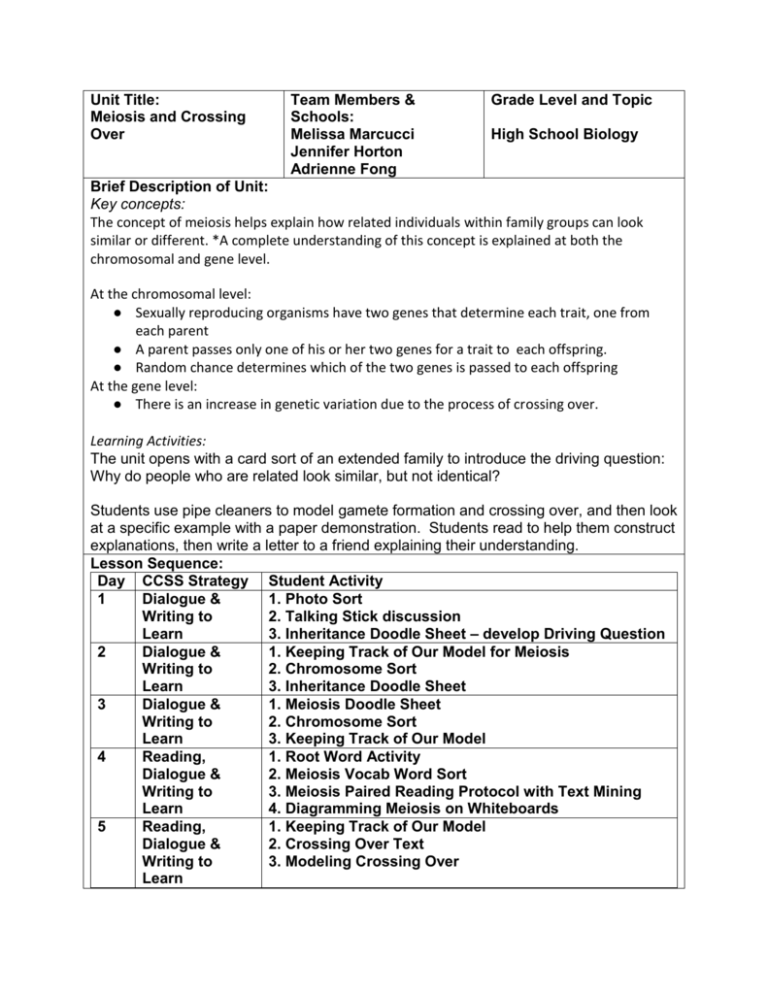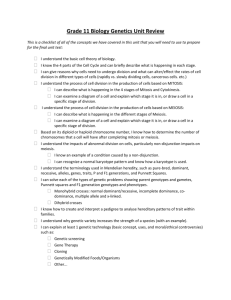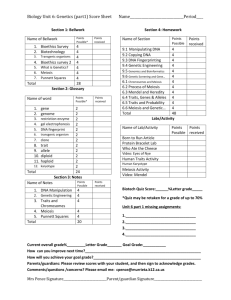doc
advertisement

Unit Title: Meiosis and Crossing Over Team Members & Schools: Melissa Marcucci Jennifer Horton Adrienne Fong Grade Level and Topic High School Biology Brief Description of Unit: Key concepts: The concept of meiosis helps explain how related individuals within family groups can look similar or different. *A complete understanding of this concept is explained at both the chromosomal and gene level. At the chromosomal level: ● Sexually reproducing organisms have two genes that determine each trait, one from each parent ● A parent passes only one of his or her two genes for a trait to each offspring. ● Random chance determines which of the two genes is passed to each offspring At the gene level: ● There is an increase in genetic variation due to the process of crossing over. Learning Activities: The unit opens with a card sort of an extended family to introduce the driving question: Why do people who are related look similar, but not identical? Students use pipe cleaners to model gamete formation and crossing over, and then look at a specific example with a paper demonstration. Students read to help them construct explanations, then write a letter to a friend explaining their understanding. Lesson Sequence: Day CCSS Strategy Student Activity 1 Dialogue & 1. Photo Sort Writing to 2. Talking Stick discussion Learn 3. Inheritance Doodle Sheet – develop Driving Question 2 Dialogue & 1. Keeping Track of Our Model for Meiosis Writing to 2. Chromosome Sort Learn 3. Inheritance Doodle Sheet 3 Dialogue & 1. Meiosis Doodle Sheet Writing to 2. Chromosome Sort Learn 3. Keeping Track of Our Model 4 Reading, 1. Root Word Activity Dialogue & 2. Meiosis Vocab Word Sort Writing to 3. Meiosis Paired Reading Protocol with Text Mining Learn 4. Diagramming Meiosis on Whiteboards 5 Reading, 1. Keeping Track of Our Model Dialogue & 2. Crossing Over Text Writing to 3. Modeling Crossing Over Learn 1. Keeping Track of Our Model – Evidence for each Claim 2. Final Writing Assessment using Communication Triangle Why this unit is Common Core: Speaking & Listening: Students process their thinking about the family card sort using Talking Stick protocol. Students work out their thinking about factors that contribute to genetic diversity using Structured Think Pair Share. 6 Writing Reading: Students use a pre-reading card sort, Paired Reading and a reading guide to gain information about homologous chromosomes, sister chromatids and crossing over. Writing: Students take on the role of geneticist to provide advice to a friend about a brother who does not look like him, using a word bank. Common Core State Standards: RST.11-12.1Cite specific textual evidence to support analysis of science and technical texts, attending to important distinctions the author makes to any gaps or inconsistencies in the account. RST.11-12.9 Synthesize information from a range of sources into a coherent understanding of a process, phenomenon, or concept, resolving conflicting information when possible WHST.9-12.1 Write arguments focussed on the discipline specific event, content. MP.2 Reason abstractly and quantitatively NGSS Elements: Performance Expectation(s): HS-LS3-2. Make and defend a claim based on evidence that inheritable genetic variations may result from: (1) new genetic combinations through meiosis, (2) viable errors occurring during replication, and/or (3) mutations caused by environmental factors. Disciplinary Core Idea(s): LS3:B Variation: In sexual reproduction chromosomes can sometimes swap sections during the process of meiosis (cell division) thereby creating new genetic combinations and thus more genetic variation. Practices: Engaging in Argument from Evidence, Developing and Using Models Cross-Cutting Ideas: Cause & Effect Unit Title: Team Members/Schools Grade Level and Topic Brief Description of Unit: Lesson Sequence: Day CCSS Strategy Learning Activities and approximate timing Why this unit is Common Core: Speaking & Listening: Reading: Writing: Common Core State Standards: NGSS Elements: Performance Expectation(s): Disciplinary Core Idea(s): Practice(s): Cross-Cutting Idea(s):







